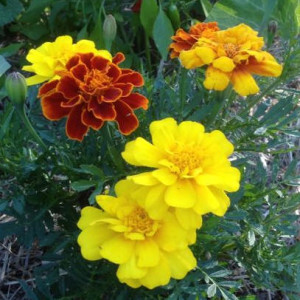Whilst we generally want to fill our plots with edible plants, adding additional flowers and plants can not only have visual appeal but also help ensure our efforts don’t go to waste by deterring harmful insects. Planting and growing insect repellent plants provide a great opportunity to add some plants which are a perfect mix of beauty and functionality.
Some people are skeptical about using plants to repel insects, whilst others are 100% convinced of the insect repelling properties of many garden plants. However, at the end of the day, if you plant some of the plants listed below, at the very least you’ll be getting some attractive plants that smell beautiful (and will help attract pollinators to your plot) and hopefully ward off some nasty bugs. Here are some ideas to get you started:
- Marigolds are best used as a ‘companion plant’ to help protect other plants. Marigolds are said to repel slugs and snails, aphids, cabbage moths, white flies and many other pests. Marigolds are particularly good at protecting tomato plants.
- Pyrethrum (Chrysanthemum) helps to repel a whole host of insects and bugs, including aphids, leafhoppers, spider mites and harlequin bugs. Best used as a ‘companion plant’ to protect other plants with its insect repellent properties, it should be planted close to plants which are affected by these insects.
To make a natural pesticide from pyrethrum flowers, dry the flowers and crush, then mix with water and steep for a few hours. The spray paralyses insects, and is best sprayed at dawn or dusk when they are least active. Do not use pyrethrum in situations where lady beetles, honeybees and other beneficials are active. Used carelessly, pyrethrum can wipe out these and other beneficial insects. - Lavender is most useful for repelling mosquitoes and gnats when planted in the garden; it can also be planted in pots and placed by doorways and windows. Cut and or dried lavender can also be placed on windowsills to stop mosquitoes entering the house. Additionally, lavender is said to repel moths so apart from in the garden, is commonly used dried to keep moths from clothes.
- Citronella grass is commonly used as an insect repellent in outdoor candles. Citronella grass is a great mosquito repellent and it can be planted and used in a similar way as citronella candles, to keep flying insects away. For best results, plant citronella grass in the garden and use in conjunction with lavender.
- ‘Masking’ Herbs – Apart from ornamental insect repelling plants, herbs in your garden can act as ‘masks’ to confuse pests and keep them away from your vegetables. Basil planted amongst tomatoes is a classic example, but also try sage, thyme and oregano (this last one is great for repelling cabbage moths) all give off strong scents which mask the scent of the target plant to confuse or deter insects. Wormwood leaves sprinkled on the ground will repel snails.
- Fly repellent – try basil, bay and mint. Cut a sprig of these herbs and put it at the back of your ears and the flies won’t come near.

